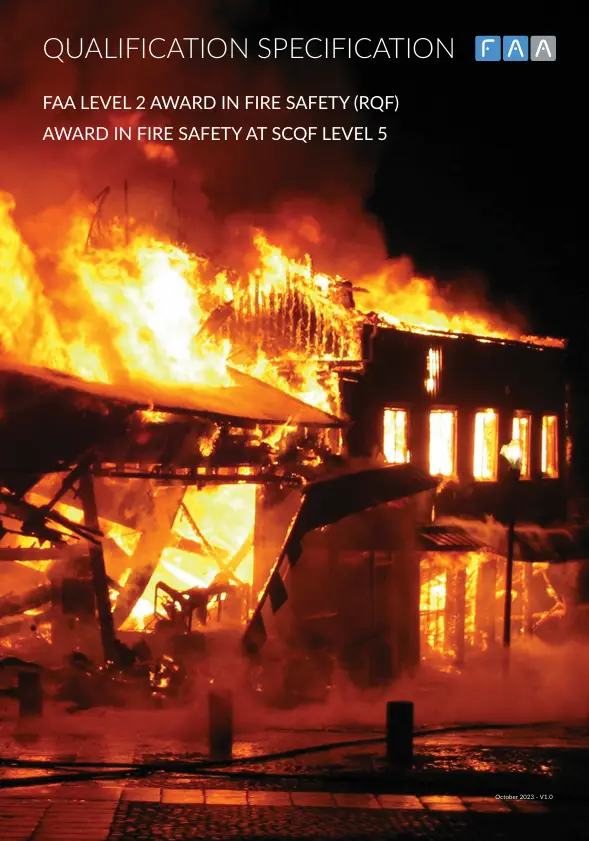
The qualification is suitable for a person who has responsibility in the workplace to undertake fire safety requirements and will provide learners with the knowledge to carry out designated duties as a fire warden/marshal.
The qualification will also increase fire safety awareness for all employees covering fire hazards, risk assessment, control of fire in the workplace, and duties of both employers and employees.
This qualification is regulated in the UK and awarded by First Aid Awards (FAA). FAA are an awarding organisation regulated by Ofqual and SQA Accreditation and the qualification sits on the Regulated Qualifications Framework (RQF) and the Scottish Credit and Qualifications Framework (SCQF).
Qualification delivery can be classroom-based or distance learning through video conferencing software
ENTRY REQUIREMENTS
The qualification is available to learners aged 14 or over.
It is recommended that learners hold a minimum of level 1 in literacy or equivalent to undertake this qualification.
It may be possible to grant a reasonable adjustment for a learner who has a disability, medical condition or learning
need following the FAA Reasonable Adjustment and Special Consideration Policy. For example, assistance could be
given with reading or writing during a classroom-based assessment.
Due to the level of unsupervised learning, a learner undertaking a distance learning course must have the literacy skills to complete the required self-study.
If a learner has any concerns they should contact their training provider to discuss before attending the course.
QUALIFICATION DELIVERY
Guided Learning Hours (GLH) indicates the number of contact hours that the learner will undertake being taught or assessed under the immediate guidance or supervision of the trainer/assessor in the classroom, or for distance learning qualifications remotely by video conferencing software.
Total Qualification Time (TQT) includes GLH but also considers unsupervised learning or preparation undertaken by a learner such as self-study or the completion of set tasks and is an estimate of how long an average learner may take to achieve the qualification.
TQT remains the same for a qualification regardless of the method of delivery but the guided learning hours (GLH) will be different due to distance learning self-study.
Classroom-based delivery
6 guided learning hours and 7 hours total qualification time.
The minimum classroom contact time of 6 hours, which includes assessment, can be delivered in 1 day or completed over a maximum of 3 weeks ensuring each session is a minimum of two hours.
The learner ratio for classroom delivery is a maximum of 16 learners to 1 trainer/assessor.
Distance learning delivery
Distance learning delivery can be by either self-study and webinars or continuous contact between the learner and trainer/assessor.
It is beneficial for a learner to undertake independent learning, for example by doing research on the internet.
The learner ratio for distance learning delivery is a maximum of 20 learners to 1 trainer/assessor.
• Self-study and webinars
3 guided learning hours and 7 hours total qualification time.
The minimum contact time between the learner and trainer/assessor by video conferencing software of 3 hours, which includes assessment, must be completed over a maximum of 3 weeks.
This method of delivery involves a combination of self-study by the learner using FAA resources and trainer/assessor webinars.
• Continuous contact by video conferencing software
6 guided learning hours and 7 hours total qualification time.
The qualification can be delivered by video conferencing software in the format of classroom delivery with the learners and the trainer/assessor in continuous contact.
The minimum contact time of 6 hours, which includes assessment, can be delivered in 1 day or completed over a maximum of 3 weeks ensuring each session is a minimum of two hours.
QUALIFICATION VALIDITY
The qualification does not have an expiry date but keeping up to date with changes to policies, procedures and new legislation through ongoing CPD is vital.
It is strongly recommended that the learner attends annual refresher training.
PROGRESSION
Learners who achieve this qualification could progress on to other FAA health and safety qualifications including manual handling. FAA also offer qualifications in first aid and related subjects, food safety, safeguarding, and first aid for mental health if a learner wanted to diversify.
Qualification specifications for all FAA qualifications can be found on the FAA website.
QUALIFICATION ASSESSMENT
There is no grading of the assessment, learners pass or are referred.
Classroom-based assessment
The qualification is assessed through a written assessment.
Distance learning assessment
The qualification is assessed by professional discussion with the trainer/assessor through video conferencing software.
QUALIFICATION STRUCTURE
The qualification consists of one unit which learners must successfully complete to achieve the qualification.
Learning outcomes and assessment criteria
FAA qualifications have set learning outcomes and assessment criteria. The learning outcomes describe the skills and knowledge a learner will gain by successfully completing the qualification. The assessment criteria state the skills, knowledge, and competence a learner will be required to demonstrate during assessment.

